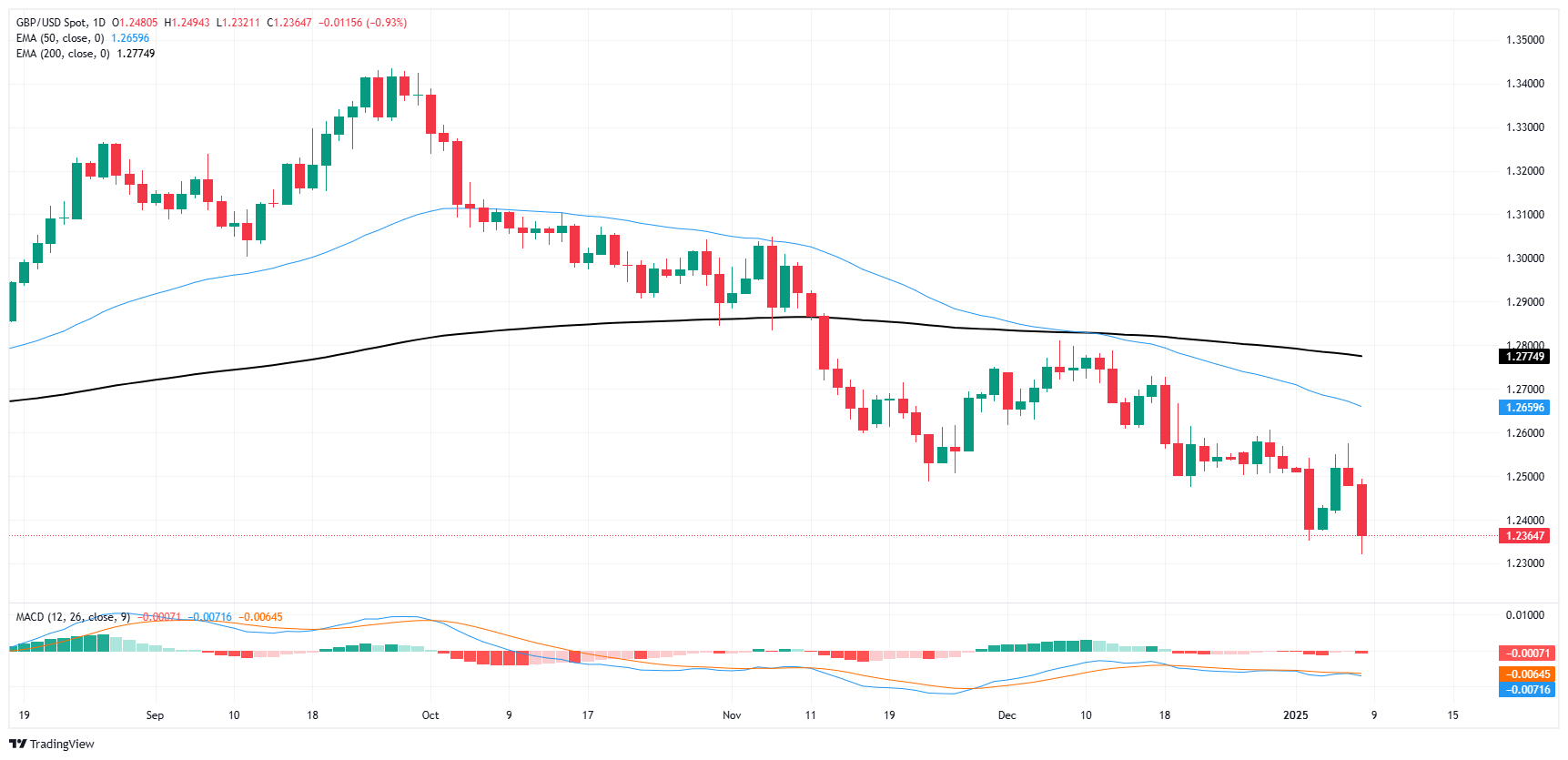GBP/USD explores further downside as NFP looms ahead
- GBP/USD shed over 0.9% on Wednesday as market sentiment droops.
- A thin data schedule on the UK side leaves Cable traders to face looming NFP figures.
- The Fed may be more concerned about government policy than previously believed.
GBP/USD sank nearly a full percent on Wednesday, falling away from the 1.2500 handle which is proving too difficult for Pound Sterling bidders to reclaim. The pair tested below 1.2350 briefly, and Cable is poised for a further dip into multi-month lows.
Meaningful economic data is absent on the UK side, a running theme for the first full trading week of 2025. Cable traders will remain exposed to broad-market flows into and out of the US Dollar as traders gear up for a hectic end to the week. A raft of speeches from Federal Reserve (Fed) policymakers await traders on Thursday, as well as Challenger Job Cuts for December, which will serve as the last punch of Nonfarm Payrolls (NFP) preview data before the bumper labor print on Friday.
On Wednesday, the ADP Employment Change report indicated a slower hiring rate than anticipated for December, with a total of 122K jobs added compared to the expected 140K and November’s 146K. Additionally, ADP wage data showed its slowest growth since mid-2021.
In the same day, the Federal Reserve's latest Meeting Minutes disclosed that policymakers might be more apprehensive about President Donald Trump's proposed tariffs than previously thought. Over the past few weeks, Fed officials had downplayed the possible effects of immigration and trade policies on their decisions, but the recent policy meeting included four discussions about significant shifts in U.S. policy that could profoundly affect central banking. Furthermore, the Fed reached a consensus that it was time to reduce the speed of rate cuts, underscoring that policy uncertainty plays a crucial role in their lowered expectations for fewer rate reductions in 2025 than the market had earlier anticipated.
GBP/USD price forecast
GBP/USD briefly tested a new nine-month low at 1.2321 on Wednesday before a half-hearted upswing later in the day, pushing the pair back above 1.2350. January trading just started, but Cable is already on pace to close in the red for a fourth consecutive month. A technical floor is priced in at the 1.2300 price level thanks to a sharp drop and turnaround at the key level back in April.
GBP/USD daily chart
Pound Sterling FAQs
The Pound Sterling (GBP) is the oldest currency in the world (886 AD) and the official currency of the United Kingdom. It is the fourth most traded unit for foreign exchange (FX) in the world, accounting for 12% of all transactions, averaging $630 billion a day, according to 2022 data. Its key trading pairs are GBP/USD, also known as ‘Cable’, which accounts for 11% of FX, GBP/JPY, or the ‘Dragon’ as it is known by traders (3%), and EUR/GBP (2%). The Pound Sterling is issued by the Bank of England (BoE).
The single most important factor influencing the value of the Pound Sterling is monetary policy decided by the Bank of England. The BoE bases its decisions on whether it has achieved its primary goal of “price stability” – a steady inflation rate of around 2%. Its primary tool for achieving this is the adjustment of interest rates. When inflation is too high, the BoE will try to rein it in by raising interest rates, making it more expensive for people and businesses to access credit. This is generally positive for GBP, as higher interest rates make the UK a more attractive place for global investors to park their money. When inflation falls too low it is a sign economic growth is slowing. In this scenario, the BoE will consider lowering interest rates to cheapen credit so businesses will borrow more to invest in growth-generating projects.
Data releases gauge the health of the economy and can impact the value of the Pound Sterling. Indicators such as GDP, Manufacturing and Services PMIs, and employment can all influence the direction of the GBP. A strong economy is good for Sterling. Not only does it attract more foreign investment but it may encourage the BoE to put up interest rates, which will directly strengthen GBP. Otherwise, if economic data is weak, the Pound Sterling is likely to fall.
Another significant data release for the Pound Sterling is the Trade Balance. This indicator measures the difference between what a country earns from its exports and what it spends on imports over a given period. If a country produces highly sought-after exports, its currency will benefit purely from the extra demand created from foreign buyers seeking to purchase these goods. Therefore, a positive net Trade Balance strengthens a currency and vice versa for a negative balance.


